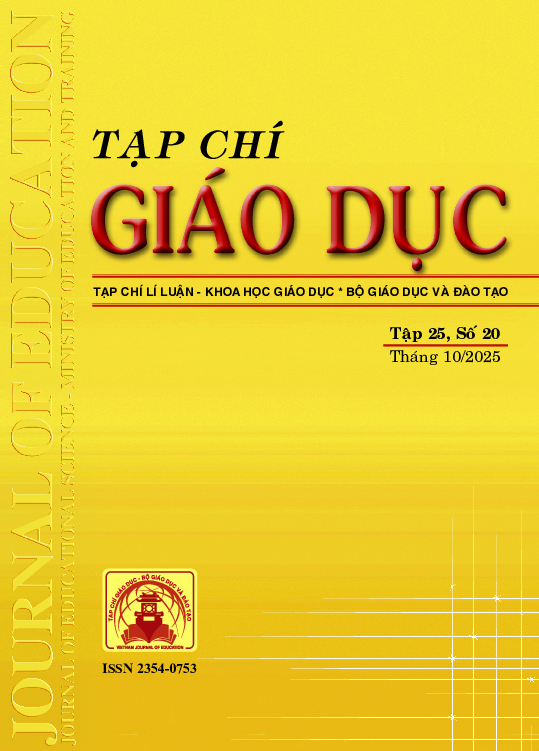Xây dựng quy trình dạy học STEM nhằm phát triển tư duy thiết kế cho học sinh trung học cơ sở
Tóm tắt
In the context of competency-based educational reform, integrating design thinking (DT) into STEM education is considered an effective approach to equip students with creative problem-solving skills and adaptability to modern life. However, the application of DT in STEM education in Vietnam remains limited due to the lack of specific pedagogical models and appropriate assessment tools. This study proposes a STEM teaching process that incorporates design thinking for lower secondary school students. The process was revised based on expert consultation to ensure pedagogical soundness, feasibility, and the ability to foster students’ design thinking in practical classroom settings. The findings contribute to enriching STEM instructional models with a clear orientation toward developing design thinking. The study also lays the groundwork for future research on designing DT assessment tools and conducting large-scale research in diverse educational contexts across Vietnam.
Tài liệu tham khảo
Alashwal, M. (2020). Design thinking in STEM education: A review. International Research in Higher Education, 5(1), 18-26. https://doi.org/10.5430/irhe.v5n1p18
Archer, L. B. (1965). Systematic method for designers. Council of Industrial Design.
Arnold, J. E. (1959). Creative engineering. Stanford University Press.
Bộ GD-ĐT (2018). Chương trình giáo dục phổ thông - Chương trình tổng thể (ban hành kèm theo Thông tư số 32/2018/TT-BGDĐT ngày 26/12/2018 của Bộ trưởng Bộ GD-ĐT).
Brown, T. (2009). Change by design: How design thinking creates new alternatives for business and society. Harvard Business Press.
English, L. D. (2016). STEM education K-12: Perspectives on integration. International Journal of STEM Education, 3(1), 1-8. https://doi.org/10.1186/s40594-016-0036-1
Faste, R. (1994). Ambidextrous thinking. Stanford University Lecture Notes.
Gonzalez, H. B., & Kuenzi, J. (2012). What is STEM education and why is it important?. Florida Association of Teacher Educators Journal, 1(August), 1-9.
Lê Hoàng Phước Hiền, Lê Thị Thu Hiền (2023). Quy trình tổ chức dạy học STEM nhằm phát triển năng lực khoa học tự nhiên cho học sinh trung học cơ sở. Tạp chí Giáo dục, 23(số đặc biệt 9), 28-34.
Le, C. N., Ho, Q. H., & Le, H. P. H. (2025). Integrating design thinking into STEM education: Enhancing problem-solving skills of high school students. Eurasia Journal of Mathematics, Science and Technology Education, 21(4), em2611. https://doi.org/10.29333/ejmste/16084
Lockwood, T. (2010). Design thinking: Integrating innovation, customer experience, and brand value. Allworth Press.
Marrero, M. E., Gunning, A. M., & Germain-Williams, T. (2014). What is STEM education? Why is STEM education?. Global Education Review, 1(1), 1-6.
Martin, R. (2009). The design of business: Why design thinking is the next competitive advantage. Harvard Business Press.
McKim, R. H. (1973). Experiences in visual thinking. Brooks/Cole Publishing Company.
Nguyễn Thị Thu Trang (2022). Dạy học tích hợp theo định hướng giáo dục STEM cho học sinh tiểu học bằng mô hình “EDP-5E”. Tạp chí Giáo dục, 22(12), 1-6.
Ruiz-Martín, H., & Bybee, R. W. (2022). The cognitive principles of learning underlying the 5E model of instruction. International Journal of STEM Education, 9(1), 21. https://doi.org/10.1186/s40594-022-00341-w
Stanford d.school. (2008). An introduction to design thinking process guide. Hasso Plattner Institute of Design at Stanford. https://dschool.stanford.edu/resources/design-thinking-process-guide
Tschimmel, K., & Santos, J. (2018). Design thinking applied in higher education D-Think, a European Project for Innovating Educational Systems. Education and New Developments, Conference Education and New Developments, Portugal, 209-213.
Tải xuống
Đã Xuất bản
Cách trích dẫn
Số
Chuyên mục
Giấy phép

Tác phẩm này được cấp phép theo Ghi nhận tác giả của Creative Commons Giấy phép quốc tế 4.0 .












